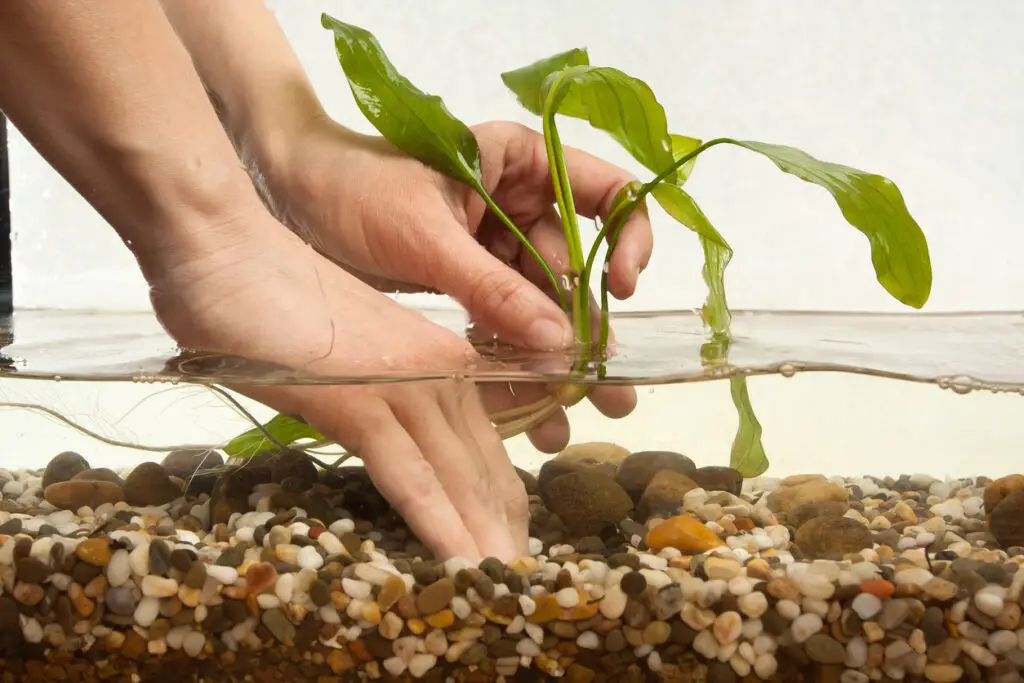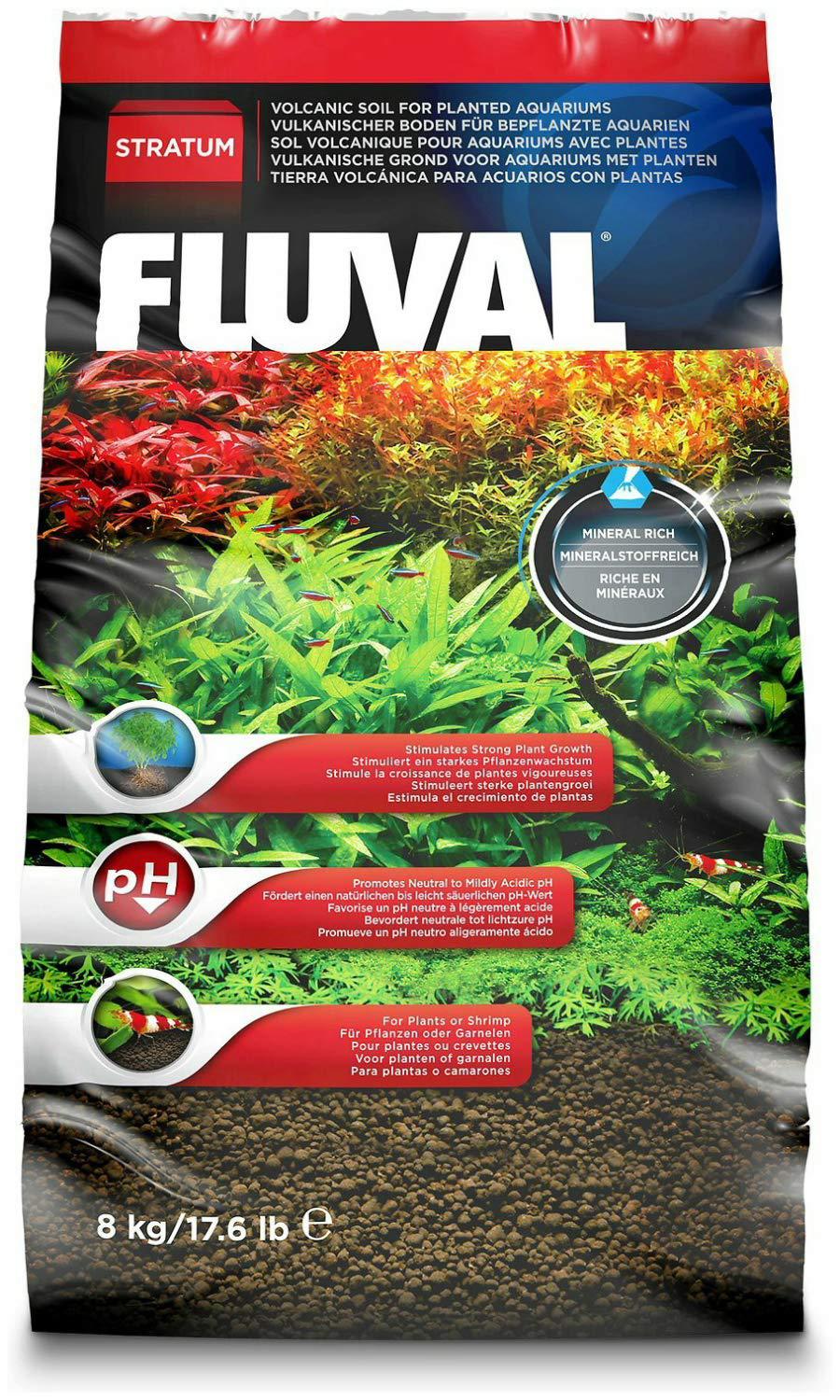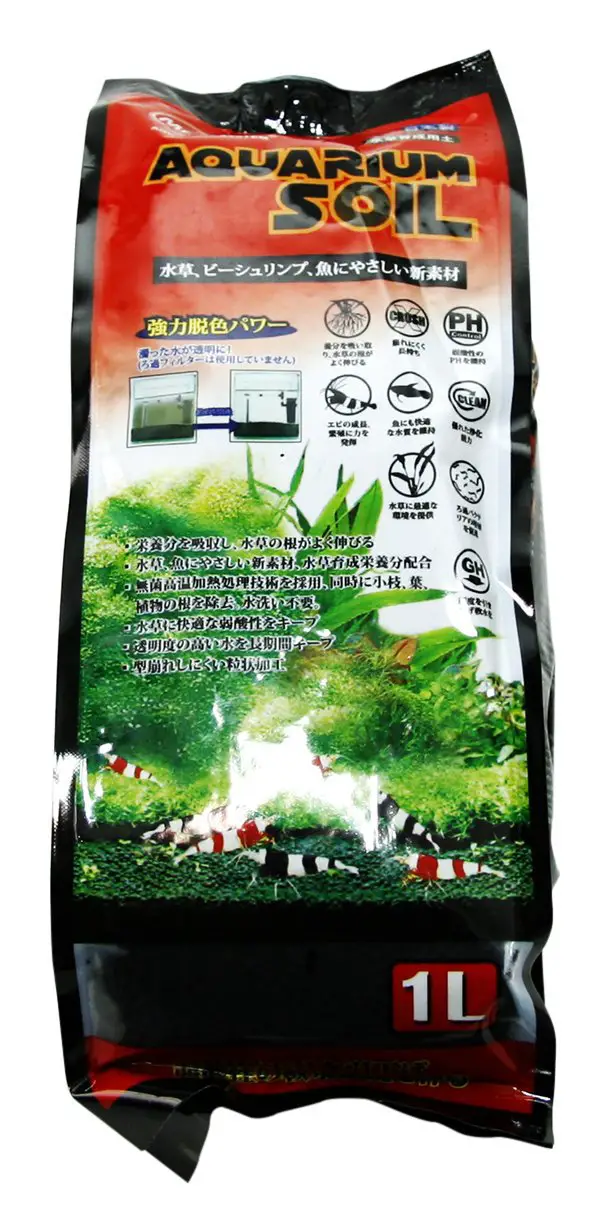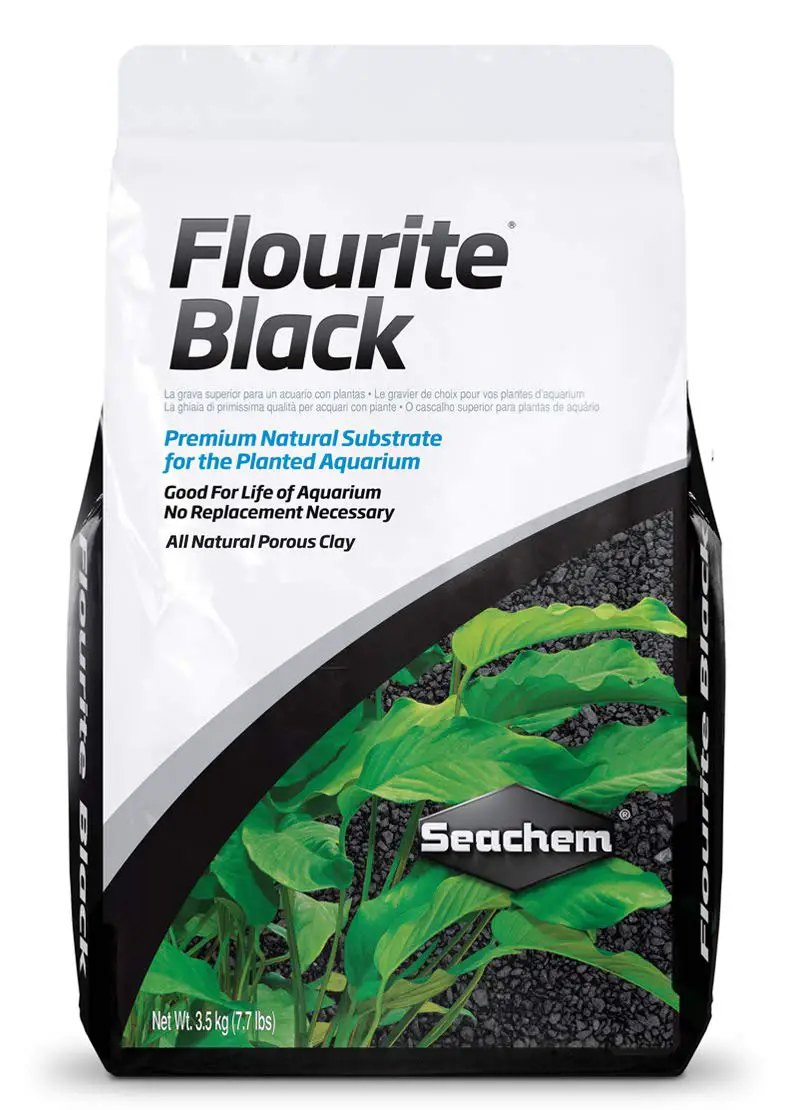Building your perfect tank is no easy task! And one of the key components you need is the right substrate for planted tanks.
There is so much involved in bringing together the tank.
Picking out the plants, accessories, fish, substrates, etc and then putting everything in the tank, making sure pH levels are correct, nutrients are there for plants and fish and so much more.
If you are considering adding aquatic plants, there are a few things you will need.
Some plants have complex root systems while others have simple root systems. Regardless, they need the right nutrients to stay healthy. That’s where substrates come in.
You wouldn’t be able to start an outdoor garden without soil! The same goes for your tank.
We have narrowed down the best substrates on the market to keep your tank flourishing.
But first, it’s best to know what substrates are and what substrates to use for different aquatic plants.
Best Substrate for Planted Tanks Quick-Find Table
| Image | Product | |||
|---|---|---|---|---|
|
EDITOR’S CHOICE
|
EDITOR’S CHOICE
|
|
|
VIEW LATEST PRICE |
|
EASIEST TO USE
|
EASIEST TO USE
|
|
|
VIEW LATEST PRICE |
|
BEST SELLING INERT SUBSTRATE
|
BEST SELLING INERT SUBSTRATE
|
|
|
VIEW LATEST PRICE |
|
BEST FOR PLANTED SHRIMP TANKS
|
BEST FOR PLANTED SHRIMP TANKS
|
|
|
VIEW LATEST PRICE |
|
BEST FOR LOWERING pH
|
BEST FOR LOWERING pH
|
|
|
VIEW LATEST PRICE |
|
BEST FOR SOFT-ROOTED PLANTS
|
BEST FOR SOFT-ROOTED PLANTS
|
|
|
VIEW LATEST PRICE |
|
BEST FOR PLANTED HERMIT CRAB HABITATS
|
BEST FOR PLANTED HERMIT CRAB HABITATS
|
|
|
VIEW LATEST PRICE |
What are substrates for planted tanks?
Aquariums are commonly set up with a single substrate or multiple that covers the bottom of the tank. Gravel, sand, river rocks, crushed coral, are just a few of the many options.
Choosing your substrate is mostly a personal preference!
When you add life to your tank, specifically rooted plant life, it’s best to have an active substrate that can provide nutrients. Adding a substrate is key to a healthy aquarium habitat, and it is aesthetically appealing.
Why is substrate for planted tanks important?
Substrates are a medium that aids in a healthy environment for plants and fish, providing nutrients, balancing pH levels, and natural water filtration.
Most importantly, substrates aid in the beneficial bacteria growth for plants, which will then continue the — very important — nitrogen cycle.
The nitrogen cycle is the natural process your aquarium goes through to filter chemical compounds in the water.
Excess plant matter, fish food, and poop cause a buildup of ammonia in the tanks’ water. A buildup of ammonia will kill almost all life in the tank.
It’s essentially death by poop, gross right!?
The beneficial bacteria in the tank will convert toxic ammonia to a less toxic chemical compound called, nitrite and from a nitrite, it will then be converted to a non-toxic compound called, nitrate.
(Yes, they are different, nitrITE toxic and nitrATE not toxic, I know it’s confusing!)
Substrate also provides a natural habitat for many kinds of fish.
Having a bare bottom tank isn’t always great for when you have a single species of fish or multiple species of fish because some fish, for example, bettas are threatened by the presence of other fish.
In some larger substrates, fish can lay eggs between rocks or marble without other fish consuming them.
A bonus, depending on the substrate you choose, bottom-dwelling fish will find more food.
Types of Substrate for planted tanks
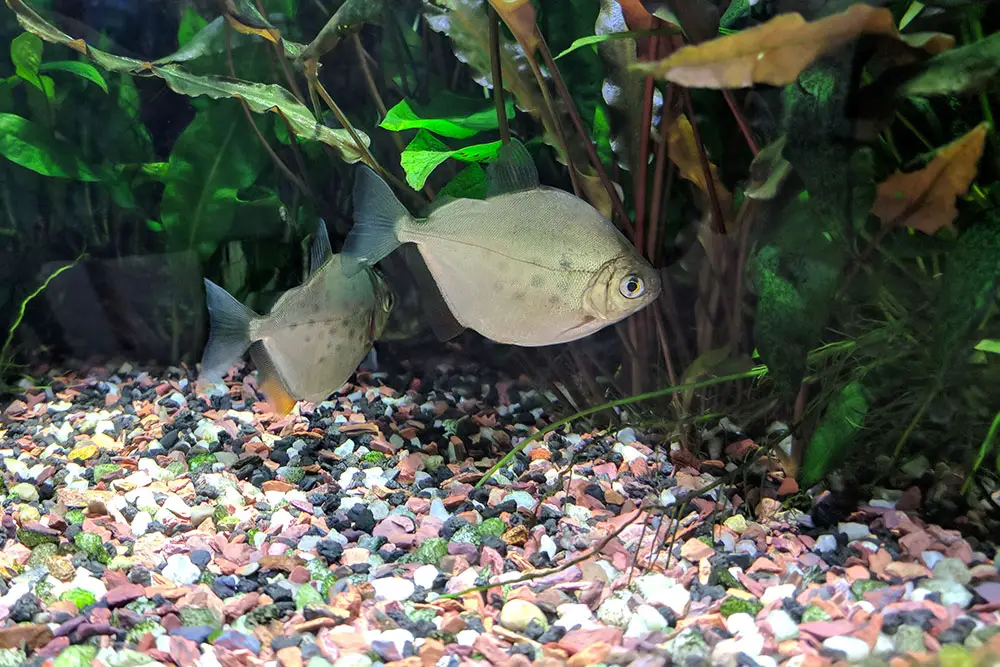
There are different substrates, some of which are for specific uses. For example, hermit crab substrate, or shrimp substrate, and some for just basic planted tanks. There are different colors, sizes, and textures.
Here are some of the most common substrates.
Aquarium Gravel
Gravel is the most popular substrate.
It is a happy medium for beginner hobbyist or for people who want a tank that’s easy to maintain. Aquarium gravel is not like normal gravel, it’s often got smother edges to make it safer for bottom-feeding species.
It is best to buy your gravel from a trusted pet brand, because they typically guarantee the product “fish and plant safe”.
Gravel comes in a variety of different colors and sizes, which makes decorating your tank even more fun.
Aquarium Sand
Sand is the next most popular substrate – it is a great beginning substrate.
It’s a good option for fish that like to burrow like, khuli loach or clams.
Unfortunately, with sand, it isn’t nutritionally beneficial to your tank. It is more for looks than it is for functioning. And sometimes, hell-raising fish that like to stir up the water can stir up the sand causing damage to your filters.
Author Note: In some cases, though, you’ll want to consider live sand. This sort of sand has healthy bacteria already growing in it. You’ll need to carefully follow guides to properly add this substrate.
River Rock/Marbles
Larger substrates like these are for display only. They offer none of the nutritional value for your planted aquarium.
It is common that larger substrates like these are mixed with other substrates like sand and gravel for a natural setting.
Using just large substrates like these, by themselves can cause more damage than good in some cases.
It has the potential to cause roots to be cut off, as well as a build-up of food, fish excretions, and plant matter, making the nitrogen cycle less effective.
If you are breeding fish, these are a good option, though, because the eggs will stay protected in the large gaps between rocks.
Complete
Complete substrates are a great bottom layer for your planted tank.
It is packed with nutrients that will promote root development, plant growth, encourage beneficial bacteria, and can provide pH buffers.
It is common to use complete substrates along with gravel, sand or marbles because complete substrates can be lightweight and porous causing tanks to easily get clouded.
There is also the potential for deep-rooted plants not staying rooted.
Clay Based Substrate
Another form of substrate is made from clay or clay composites.
The clay is inert, meaning it won’t affect aquarium chemistry.
The clay is hard baked and lasts forever – as long as you carefully manage your aquarium, cleaning it properly.
Clay substrate does require fertilization for your plants, though, as the clay doesn’t offer any nutrients the plants can take in.
Author Note: Even if you don’t maintain it well, you can thoroughly clean the clay and reuse later, if so desired.
pH Boosting substrate for planted tanks
Another type of substrate for planted tanks is pH boosting substrate.
This substrate is usually made of crushed coral.
This type of substrate is suited to fish who don’t dig into the substrate and require high pH levels (like African cichlids).
This type of substrate elevates your pH levels so that you don’t have to do the work for it yourself.
Author Note: They’re not usually used in planted tanks but there are some rare cases when a certain combination of plants and animals require this sort of substrate.
How much substrate for planted tanks do you need?
Deciding how much substrate is needed will depend on the size of the tank, and the plants you plan on putting in it.
Deep-rooted plants such as dwarf sag and eel grass will need more than say java moss.
Top Tip: The average amount is 1 ½ – 2 inches from the bottom of your tank.
Adding too much substrate can be problematic because it causes a build-up of anaerobic gasses.
Also, having large materials like river rock can block root growth, but on the other hand too small of a substrate like some forms of sand can crush root systems.
Substrate with Common Plant types
One of the most important things to consider when adding a substrate is the type of plants you are planning to add. There are two types of plants that are found in aquariums.
Water column feeders
Floating and stem plants are classified as water column feeders because, they get most of their nutrients from the water, such as java fern and abnubias.
This means they will not require a substrate to get nutrients from.
Root feeders

Root feeding plants, you guessed it, get their nutrients from the soil/substrate or gravel such as dwarf baby tears and sword plants.
These plants require something like a Complete Substrate.
How We Chose The Best substrate for planted tanks
With hundreds of options to choose from it can be overwhelming when trying to narrow them down. That’s why we have searched through the hundreds of options for you, researching to find the best substrates for planted tanks.
Nutrients
Identifying the nutrient contents in substrates is a very important by decision. You need to consider what types of plants you want, any fish that will be added, and the longevity of the product.
Water chemistry
Depending on the substrate you decide on, consider the effect it will have on your water balance.
The main point of adding a substrate is to create a healthy environment for both plants and fish.
While plants are the focus of the substrate, there are other effects it can take on the water. For example, hard water or soft water? pH levels? Ammonia, nitrites, and nitrates?
These differences are referred to as active and inert substrate.
- Active = alters water chemistry
- Inert = doesn’t alter water chemistry
Other aquarium life
Depending on what you want for your tank, you will have to weigh your options with not just water chemistry but, substrate textures. Rough textures can cause damage to fins, scales, and mouths of bottom feeders.
Best Substrate for Planted Tanks
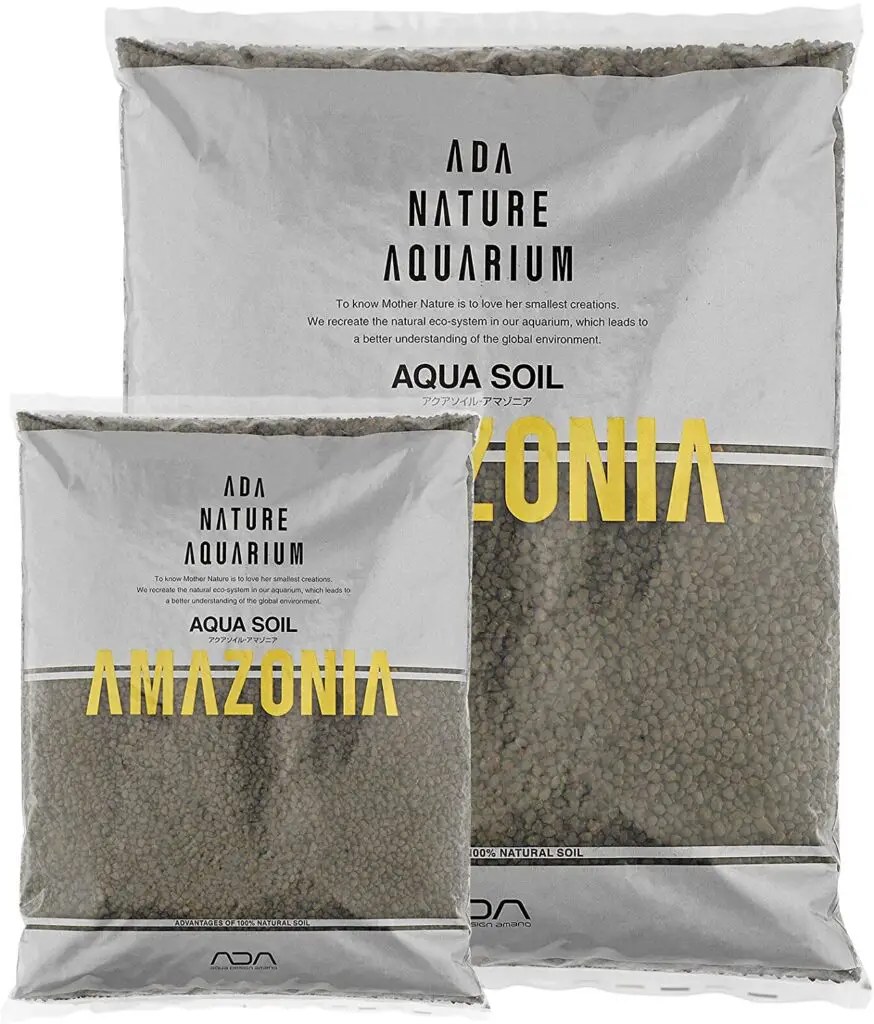
ADA Aqua soil is a Japanese plant-based soil made from decomposed leaf mulch, that is rich with elements and nutrients to help your aquarium plant life flourish.
It has a beautiful natural appearance that will complete any tank.
This aqua soil contains tons of nutrients for your aquarium plants. It is an active substrate, meaning it comes already packed with a bunch of nutrients – there is no need for additives.
It can also help bring down pH levels and hardness of the water.
If you are planning on adding any fish, it is best to wait a week or two before adding them.
What ADA Aqua Soil actually looks like
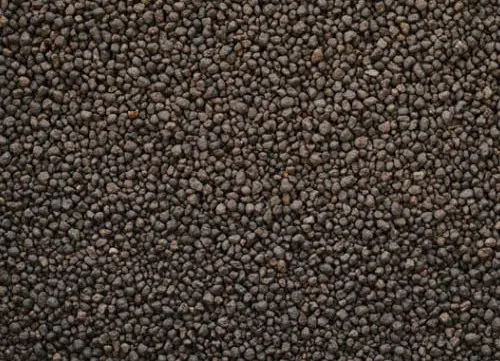
This soil substrate leeches a good amount of ammonia when first added to the tank, making it unsafe for fish and even some aquatic plants.
It is best to give this soil a week or more to settle, it can stir up easily and needs ample time to level out pH, hardness, and ammonia.
This substrate is best for intermediate to advanced hobbyists.
An alternative for beginners is the ADA Aqua soil Light.
>> Tap Here to Read More Reviews and See Today’s Price on Amazon.com <<
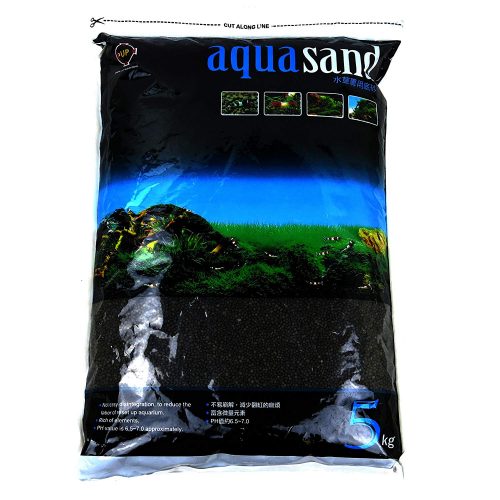
This is one of the top rated substrates on the market. There are so many benefits to using it and there are not too many complaints about the product other than delivery issues.
When opening the bag there is no dust like what you would experience with other products. With having virtually no dust, there is minimal prep time and it doesn’t need to be thoroughly washed before adding to your tank.
Up Aqua sand is packed with nutrients, it is specifically made for planted tanks with or without fish.
It can help lower and maintain pH levels, as well as being lightweight and porous.
It is a great choice for deep rooted plants or soft rooted plants because its pores aids in the root development and stability of either.
What Up Aqua Sand actually looks like

The breathable porous nature helps it circulate healthy bacteria while making the perfect environment inside your tank.
It is easy to maintain because of its longevity and its larger granule size. It is not the size of sand you’d find on the beach, but a little larger.
If you are looking for a true black you might want to look elsewhere because it has a grey hue to it, but functionally it’s awesome.
>> Tap Here to Read More Reviews and See Today’s Price on Amazon.com <<
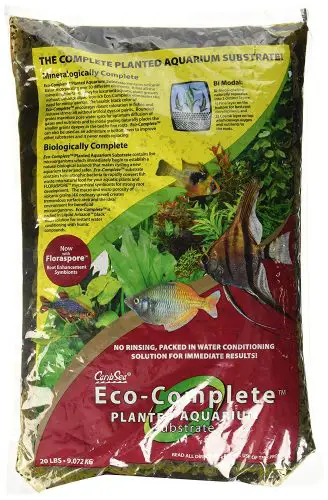
This complete substrate made second on the list because you get the best bang for your buck. It is the number one best seller on Amazon and here’s why.
CaribSea Eco-Complete is made from volcanic soil that is packed with nutrients such as iron, magnesium, calcium, potassium, sulfur and 20 plus more.
Iron is a big selling point when it comes to this product, as it is essential to plants growth and color – it aids in the plants’ chlorophyll process, which in turn can make more vibrant colors and a visible increase in plant health.
Most other products would require a laterite additive…CarbiSea eliminates that extra step. It is also free of dyes, paints, and chemicals.
What CaribSea Eco-Complete actually looks like

While this can be added to an existing tank or newly planted tank with little prep time, it is only meant to be used for freshwater aquariums. You might also notice a little bit of an unpleasant odor when you first open the bag.
Overall, though, it’s a fantastic option if you’re looking for something inert.
>> Tap Here to Read More Reviews and See Today’s Price on Amazon.com <<
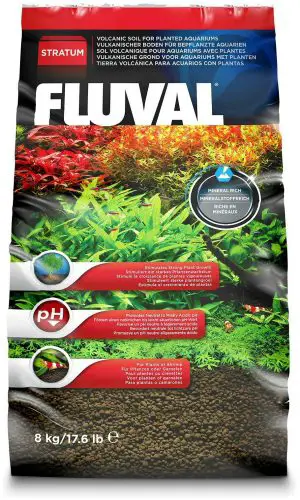
Fluval Plant and Shrimp Stratum comes from a natural, mineral-rich volcanic soil.
It is a good option for small aquariums but will work well with other sizes, too.
The substrate is lightweight which could be a problem for a tank with fish that like to raise a ruckus and because of its lightweight properties, it works best with soft rooted aquatic plants.
The natural volcanic soil promotes root development and can help lower pH levels.
In most cases, it can help to reduce water discoloration but consequently, it can break down over time, resulting in cloudy tanks if not changed frequently (more frequently than other products).
What Fluval Plant and Shrimp Stratum actually looks like
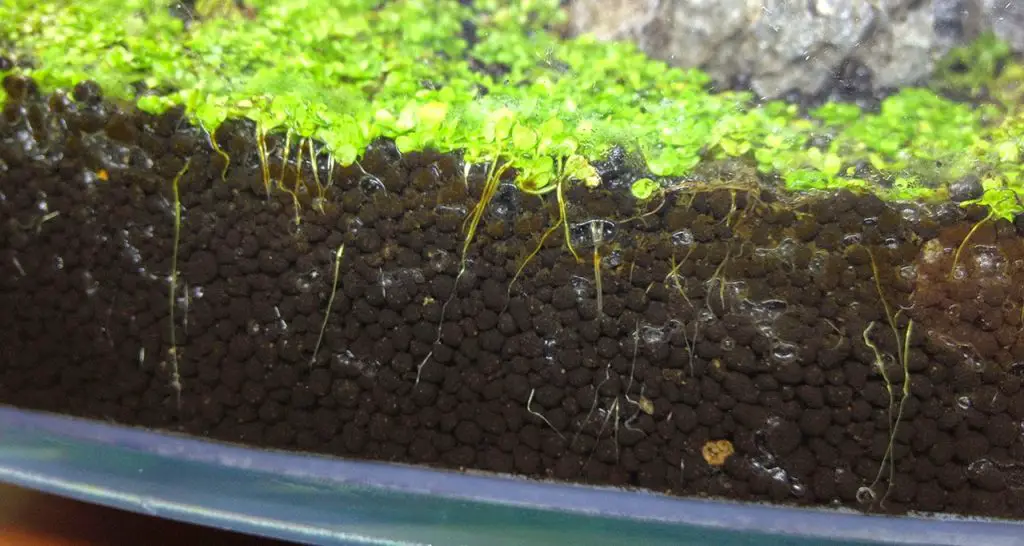
This is the best soil substrate for shrimp. It is porous, which makes it ideal for new born shrimp – they can take refuge in the soil until they are large enough to safely come out.
>> Tap Here to Read More Reviews and See Today’s Price on Amazon.com <<

This substrate is composed of organic and inert ingredients that provide essentials to plant life in your tank.
This nutrient dense substrate is light and porous which makes it an ideal substrate for the growth of beneficial bacteria.
This black soil also maintains pH levels in the water to a 6.2-6.7 range.
Since this substrate naturally manages pH, it can prolong water changes, and lasts about 12-18 months before needing to be changed.
What Mr. Aqua actually looks like

Mr. Aqua soil has many organic compounds that encourage strong root development and plant growth.
It is ideal for inhabitants that prefer softer water like betta fish.
>> Tap Here to Read More Reviews and See Today’s Price on Amazon.com <<

Seachem is a clay-based substrate, rich in iron. It has a sleek natural appearance and comes in a couple different colors. It is formulated for long-term use and will not alter the pH levels.
Seachem is best to use this substrate alone because it comes in all different shapes, sizes, and textures in each bag.
There may be pieces that are smooth, rough, round, small, large, etc.
Because of its texture differences it isn’t recommended for tanks that have bottom feeding fish.
The major selling point Seachem is the longevity of the product…it never needs to be replaced.
Also, made with no added chemicals or coatings, it won’t alter the pH levels.
The fluorite stones help promote beneficial bacteria growth, but they won’t let off any ammonia to aid in the nitrogen cycle.
What Seachem Flourite Black actually looks like
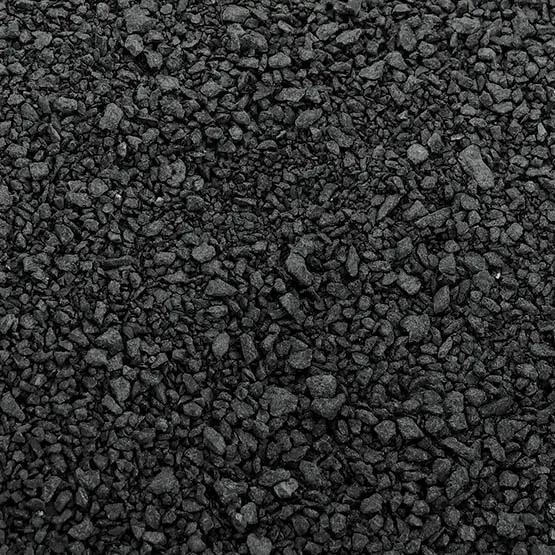
It is also rich in iron which can make plant colors really vibrant.
Unfortunately, it doesn’t offer more nutrients like other substrates would. You can always add Seachem root tabs for an added nutrient boost.
This can be used in new or already existing tanks. Be sure to wash the fluorite thoroughly before adding it to you tank. It is lightweight but not so much so that your plants can’t be anchored well.
>> Tap Here to Read More Reviews and See Today’s Price on Amazon.com <<
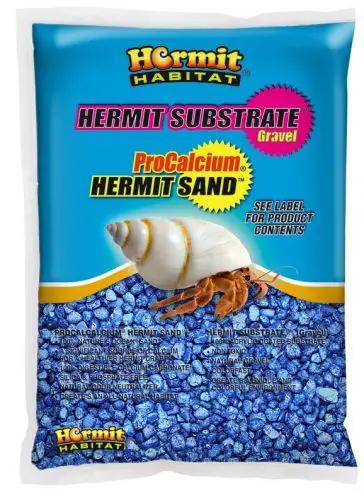
This is the most basic substrate for planted tanks. It is blue in color and acrylic coated so your water won’t change color. Hermit Habitat does not offer any nutrients for your plants and it needs to be replaced every six months.
What Hermit Habitat actually looks like

This makes for a great pair with other complete substrates such as ADA or Fluval, it is the best option if you’re looking for more color in your tank.
>> Tap Here to Read More Reviews and See Today’s Price on Amazon.com <<
Setting Up And Cycling Your Tank
This is an important part of adding substrate to a new tank. As mentioned before, the nitrogen cycle will need to take place in order for your tank to be inhabitable.
These are general guidelines for new tanks and already established tanks.
- Pick the plants and substrate(s) of your choice. Make sure the substrate will be beneficial to your plant life and fish.
- Add just your substrate(s) to the bottom of the tank.
- Slowly add water into the tank, making sure that the gravel/substrate don’t get stirred up in the process. It is best to add any hardscapes at the same time to make sure you don’t overfill your tank.
- Time for plants! Carefully remove any rock wool or fiber wool that the plant is usually packaged with.
- Take your finger and create a hole in gravel layer but not deep enough to hit the substrate(if you have set it up with multiple layers). Go ahead and put the plant in and gently cover the roots in gravel to anchor it in place.
If this is a new tank you’ll want to make sure you don’t need to add your fish right away, because ammonia can be leached from the substrate in toxic amounts within the first two weeks.
After the recommended amount of time your tank will have gone through the nitrogen cycle and the chemical compounds in the water should be balanced.
Top Tip: You can always buy freshwater testing kits, which are your best friend when starting a new aquarium.
FAQ on Substrate for planted tanks
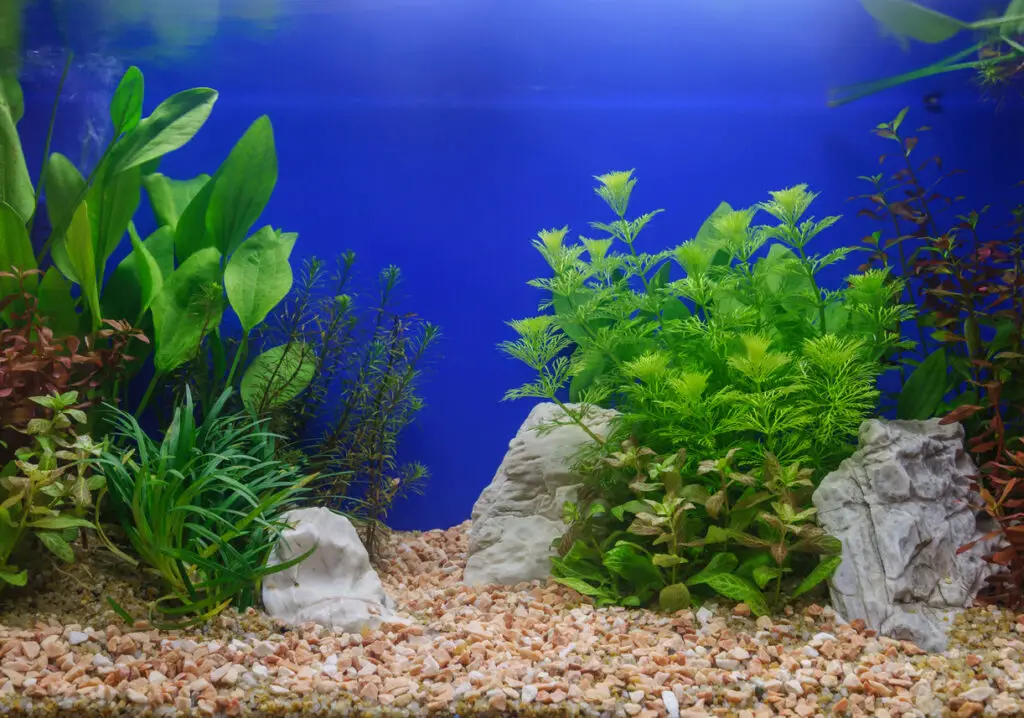
Q: When can I add fish/plants?
If you are adding a complete substrate or nutrient rich substrate it is best to wait up to two weeks to add fish because of the ammonia that it releases, this all depends on the type of substrate you add.
Q: Can I use topsoil as substrate for planted tanks?
Absolutely, but there are a couple things you should consider before adding top soil.
Topsoil is made up of smaller lightweight particles, which can float around. If you plan on adding a top soil it’s recommended that you have a layer of gravel or substrate to prevent that from happening.
It can also affect water’s’ pH levels, so be prepared if you have plants or other critters that will be affected by pH fluctuations.
Q: How deep should it be?
The depth of your substrate will depend on the type of aquarium plants you choose, as well as the size of the tank.
Deep-rooted plants will require more depth if it doesn’t have enough depth the plants will essentially suffocate. If there is not enough depth the roots will become entangled and there will be a lack of nutrients.
Q: Does substrate for planted tanks need to be changed, Cleaned, or vacuumed?
Maintenance will depend on the type of substrate that you choose.
River rocks, marbles, and gravel will need to be washed before being put in the tank.
Gravel and substrates alike will need to be vacuumed to remove the build-up of dead plant matter, fish poop, and fish food.
Most complete substrates will lose nutritional value after an extended period of time. At that point it is required to be changed according to the type of complete substrate.
Q: What about pH levels with substrate for planted tanks?
The pH levels of your tank are a crucial part of your aquarium habitat. Without having the correct pH levels, there could be negative consequences for your plant life and fish life.
Having a pH between 6.8 to 7.2 is an ideal pH level for basic planted aquarium. Again, this will all depend on the plant and fish life that you have in your tank.
Substrates like many other factors in your tank will have some effect on the pH levels.
Crushed coral will increase your pH levels more than other substrates will.
Gravel, river rock, sand, and marbles shouldn’t have too much effect on your pH levels.
Complete substrates will typically lower pH levels.
Q: Can colored substrate for planted tanks affect the water chemical compound levels?
As long as the substrate is not colored with any artificial dyes, paint or chemicals the color shouldn’t affect the water’s chemical compound.
It is important to buy substrates through reputable companies, like those we reviewed above, where you can be ensured the product is of high quality.
Q: How many bags of substrate for planted tanks do I need?
This will all depend on the size of tank you have as well as the substrate you choose. A general guide to go by is a 1lb bag per gallon. For example 5 lbs of substrate for a 5 gallon tank.
Conclusion on substrate for planted tanks
With all the provided information it can be very overwhelming to make the right decision. If our a beginning aquarium hobbyist CarbiSea is you best option.
It’s organic and comes loaded with many the nutrients plants need. To top it off it doesn’t require a ton of maintenance.
It is always best to take into consideration what you will plan on using the substrate for because there are many options for different planted tanks. It’s your tank to choose what will work best for you!
